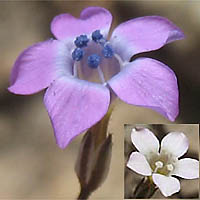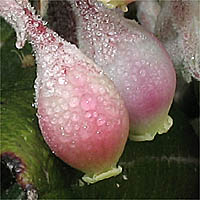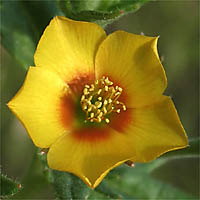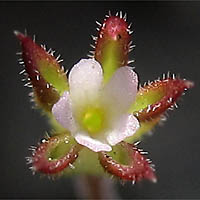|
Bridges' Pincushionplant
Navarretia leptalea
TJM1: Gilia leptalea.
Family: Polemoniaceae (PHLOX).
Other common names: Bridges' gilia.
Generic common name: PINCUSHIONPLANT.
Location: Triunfo Creek Park: Amid scree of north-facing rocky slope above Triunfo Cyn Rd, March 2010.
Characteristics: Native, White, Red, Medium, Solitary, Simple, Herbaceous, Annual, Early Spring.
Tentative ID
The use of the Jepson identification keys on this plant is not straight-forward and consequently there are a number of issues with this ID, even at the level of Genus. Making matters more difficult this plant cannot be found every year and therefore has not been seen frequently. The pictures shown here are from two small populations located about 700 yards apart in Triunfo Creek Park, both in full sun on thin rocky soils of north-facing slopes. The pictures from population 1, located near Triunfo Canyon Road, were photographed between mid-March and mid-April of 2010. Population 2, located below the east security fence of the Las Virgenes Reservoir, were photographed in early April of 2019. It is worth noting that the 2019 plants would have been influenced by nutrients released by the November 2018 Woolsey fire, and indeed, we saw other species in the vicinity that were quite large and robust compared to more typical years.
From the note in A N F under the genus Gilia regarding population 1:
NB. There is considerable variation in gilias within range, from site to site and between good and poor rain years, so it is still unclear how many species and subspecies should be listed. For example, in 2010 a population was discovered by SMMNRA staff growing in full sun on a rocky slope along Triumfo Canyon Road in Westlake Village (SMM), occurring with many other native herbs on very thin soil. It has 3-seeded capsules and resembles Gilia but could also be a non-spinescent species of Navarretia, e.g., N. leptalea (A. Gray) L. A. Johnson; unfortunately, the plant has not appeared in subsequent dry years, and needs to be studied more carefully. This unidentified polemon has dark lavender to pink corolla lobes, light violet filaments ca. 0.8 mm long having light blue anthers, and an included pistil with the stigmas positioned several millimeters below the anthers.
And in A N F under Navarretia:
NB. Populations of Navarretia throughout the range need much more study to sort out identifications and degree of variability. Problems to studying this group include the oddity that this group blooms during the dry season, when botanist tend not to be out collecting plants in southern California. Populations are also small and widely dispersed, and are undependable as to in what year they will germinate. Materials from range until now have not received much notice, whereas our populations may provide insight into how broadly species should be defined.
.
|
 |




